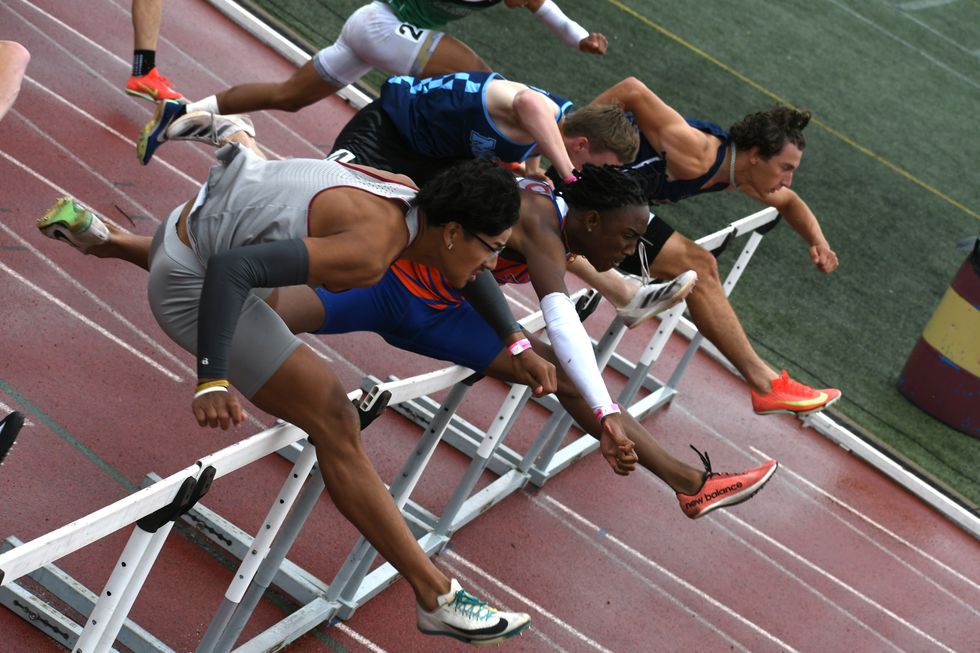Latest News
Anthony Labbadia set a new HVRHS record with a 44-foot one-inch triple jump June 14. The distance earned him 9th place at the New England track and field championship, which this year was held in New Britain, Conn.
Photo by Riley Klein
NEW BRITAIN — Anthony Labbadia soared to 9th place in the triple jump at the 2025 New England track and field championships Saturday, June 14.
On his first attempt of the event he leaped 44 feet and one inch, qualifying for the finals and setting the new Housatonic Valley Regional High School record. The previous school record of 43 feet eight inches was set by Don Hurlbutt in 1967.

Conditions were rainy for the meet with the grounds crew utilizing a leaf blower to dry the track between events. Labbadia said he had experienced similar weather at the Berkshire League championships in May, and he won the triple jump there, so he was confident.
“It doesn’t bother me,” said Labbadia of the rain, noting he was excited to be back at Willow Brook Park. “Being here makes me jump farther... I just have to make sure I’m thinking about everything without overthinking.”
Labbadia, a rising senior at HVRHS, wrote his capstone on the triple jump. In his research, his mother explained, he studied and broke down the biomechanics of the event.

Two days before the championships, he made a bold change to his jumping approach — switching from a “right, right, left” sequence to “left, left, right” — and it paid off.
“I’m glad I switched my feet,” he said after the result. “I’m happy with my performance.”
Once all the jumpers from Connecticut, Maine, Massachusetts, New Hampshire, Rhode Island and Vermont had finished, Labbadia’s distance held for 9th place.
The triple jump gold medal winner was Amar Skeete, sophomore from Catholic Memorial High School in West Roxbury, Massachusetts, who jumped 48 feet two inches. The 2nd place finisher was Mitch Krasco of Mahar Regional High School in Orange, Massachusetts, with a distance of 46 feet two and a half inches. Jessie Singleton Jr., junior at Bloomfield High School in Connecticut, placed 3rd with a distance of 45 feet ten inches.
Labbadia was the first HVRHS athlete to compete at the New England meet since Sydney Segalla in 2022. Track coach Alan Lovejoy said he cannot recall another HVRHS male athlete qualifying since he became coach in 2009.


Keep ReadingShow less
Pirates go back-to-back as league champs
Jun 14, 2025
The Canaan Pirates pose as champions after defending the Northwest Connecticut District 6 Majors Little League title.
Photo by Riley Klein
THOMASTON — The Canaan Pirates are champions once more.
In the Northwest Connecticut District 6 Majors Little League title game Friday, June 13, the Pirates defeated Thomaston JRC Transportation by a score of 6-2.
Brody Ohler pitched a two-hitter for Canaan. Milo Ellison relieved him, facing one batter who flew out to right field where Ben Young secured the final out.
Canaan never trailed in the game against top-ranked Thomaston, which lost one game all season prior to the championship. Both JRC losses came from the Pirates, with players aged 10 to 12 from Cornwall, Falls Village, Kent, Norfolk, North Canaan, Salisbury and Sharon.

In the title game at Reeves Field in Thomaston, the Pirates started strong with a lead in the top of the first inning. Ohler singled, then stole second base. Liam Downey brought him home with a single, then Sam Hahn doubled to put runners on second and third. Ellison brought them both home with a triple and the Pirates took a 3-0 lead.
The margin held until the sixth inning when the Pirates extended their lead to 6-0. With J.T. Farr and Bentley King on, Ohler sent a deep shot to center field and rounded the bases for an in-the-park home run.
In the bottom of the sixth, Ohler surrendered two runs before reaching his pitch limit. Ellison stepped in to end the game with some help from Young in right field.
The Pirates piled on Young in the outfield chanting “Benny! Benny!” The two sides shook hands in the spirit of sportsmanship before trophies were awarded.

After winning the District 6 title for the second straight year, Coach Tom Downey said "It feels awesome. Especially this group who worked really hard. Last year we were dominant, this year these guys worked their butts off."
"We definitely earned it," said third baseman Michael Prisco.
Ohler finished with nine strikeouts on the mound, three hits in three at bats, two RBI and a home run. Ellison hit 1-for-2 with two RBI, Liam Downey went 1-for-3 with an RBI, Sam Hahn and J.T. Farr hit 1-for-3 and Sam Hamlin hit 1-for-2.
For Thomaston, Owen H. hit 1-for-2 with two RBI and Lucas K. hit 1-for-2. The pitching trio of Gavin M., Jackson Ether and Brody Conlon combined for 12 strikeouts.

Keep ReadingShow less
Red Sox end season with comeback win
Jun 13, 2025
NORTH CANAAN — The Canaan Red Sox ended the season with a thrilling 14-13 win over the Tri-Town Phillies Thursday, June 12.
Canaan trailed for most of the game but kept it close. Ultimately, the Red Sox secured the victory with a final-inning comeback in front of the home crowd at Steve Blass Field.
The Red Sox rejoiced as victors. Reflecting on the season, Coach Nikki Blass stated, “My boys continue to come off the field smiling and doing better than the game before.”
The Red Sox are part of the Northwest Connecticut Steve Blass Little League AAA program, consisting of players aged 9 to 11 from Cornwall, Falls Village, Kent, Norfolk, North Canaan, Salisbury and Sharon. Tri-Town includes players from Goshen, Litchfield, Morris and Warren.

The result June 12 marked the first win of the season for the Red Sox. The night before, Coach Nikki Blass reassured her team with a letter, writing, “You should keep your heads high and know that you are all an asset to this team. Tomorrow we are clearing the slate and we will win.” She continued, “I hear in addition if you put a bat under your bed you get an amazing hit on game day.”
The bat trick paid off and many Red Sox logged hits in the game. “Everyone was on fire,” exclaimed Blass after the game.
Quinn McKniff pitched the majority of the match for Canaan with reliever Myles Shippa taking the mound for the final inning.

Offensively, Blaze Freund logged his first hit of the season. His twin brother Roan scored after sliding head-first into home “Pete Rose-style.” Myles Shippa recorded an RBI double in the game.
The Red Sox gathered beneath the scoreboard for a team photo after the win. With wide smiles and baseballs held high, the players ended another joyous Little League season.
Written by Riley Klein with reporting from Simon Markow.

Keep ReadingShow less
State Rep. Maria Horn (D-64) was treated for her injuries at Sharon Hospital.
Photo by John Coston
The day after concluding what has been described as a grueling legislative session, State Rep. Maria Horn (D-64) had a running accident, leaving her with a broken pelvis and collarbone among other more minor bruises and abrasions. Despite the injuries, she is in good spirits and recuperating at home, eager to get back on her feet.
Horn said after spending weeks in the assembly hall, she was eager to get some outdoor exercise in, but perhaps pushed a little too hard too soon. She said she was excited to get a run in on the morning of Friday, June 6, but was still exhausted from her time in Hartford and in the final stretch of recovering from a meniscus repair surgery in December.
Before the run, she told friends she was hoping for a “hard reset for [her] health,” she said with a rueful laugh.
Nearing the end of the loop, Horn said her leg was fatigued and gave out, causing her to fall on the pavement. She is grateful for the community members who helped during the ordeal, including an unknown motorist who waited with her until her husband arrived, and the staff at Sharon Hospital who she said were “wonderful.”
She was directed to keep weight off her hip for 4 to 6 weeks, and since her collarbone is also fractured, cannot use crutches so she’s partially wheelchair-bound for the time being. While she’s disappointed to be missing out on the start of hiking, biking and running season, she’s keeping her sights forward and focusing on recovery.
In the meantime, she said she’s grateful for the video and photo updates from her son, who is hiking the Connecticut portion of the Appalachian Trail: “I’m living vicariously through him.”
Keep ReadingShow less
loading







